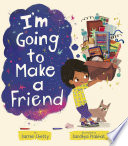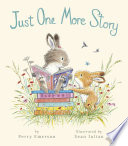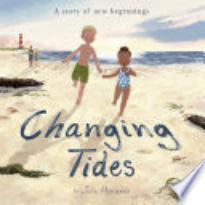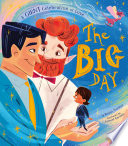Tiger Tales
137 Reviews
(2)
PS
This title encourages youngsters to flip the book on each and every double-page spread to experience the opposite. A bird flies high, but when turned over is headed in descent. A snail in the rain stays dry by clinging below the leaf, but gets wet when the book is reoriented. McLean’s rhyming text flows smoothly and pairs well with Hunt’s clean, soft-toned graphics. Also in the series: Upside Down Animals. Review covers these titles: Upside Down Animals and Upside Down Opposites.
(3)
K-3
Illustrated by
Sandhya Prabhat.
After moving to a new neighborhood, a young child uses scrap items to build a robot friend. The bright digital illustrations capture the child’s journey from loneliness to connection. When the protagonist meets another youngster, the two initially clash over the robot, but through teamwork and empathy, they rebuild it together. This sparely written story encourages creativity and highlights the importance of cooperation, forgiveness, and understanding in building friendship.
Reviewer: Summer Edward
(3)
K-3
Illustrated by
Sean Julian.
Pip is a bunny who loves reading; Bun isn’t interested (“You have to sit still and be quiet forevvvvver”) until some reverse psychology changes his mind. When they run out of stories, they make up their own...which brings creative differences. This ultimately sweet story of conflict resolution encourages readers to find their own approaches to reading and storytelling. Bucolic illustrations on creamy white backgrounds add plenty of charm.
Reviewer: Shoshana Flax
(2)
K-3
Illustrated by
Julia Christians.
When a man with a white beard moves into the unnamed narrator’s busy, diverse neighborhood, only she believes he’s Santa. He becomes a fixture, raising rabbits and opening a workshop to which everyone brings broken things, including the girl’s father’s motorcycle. When the man gets sick, she organizes the neighbors to bring him medicine and food, and he gets better just in time for Christmas Eve. A final illustration shows the neighborhood gathering outside for a celebration -- while, flying against a full moon, we see a man on a motorcycle pulled by rabbits. An uplifting Christmas story about the power of belief and the importance of community, with cheerful illustrations containing not a few hints to the man’s true identity (our narrator was right all along).
Reviewer: Martha V. Parravano
| Horn Book Magazine Issue:
November, 2025
(2)
PS
Illustrated by
Matt Hunt.
This title encourages youngsters to flip the book on each and every double-page spread to experience the opposite. A bird flies high, but when turned over is headed in descent. A snail in the rain stays dry by clinging below the leaf, but gets wet when the book is reoriented. McLean’s rhyming text flows smoothly and pairs well with Hunt’s clean, soft-toned graphics. Also in the series: Upside Down Animals. Review covers these titles: Upside Down Animals and Upside Down Opposites.
(2)
K-3
A blended biracial family comes together for a beach day. The seaside is young Lula's "favorite place," and she's excited to be going with her dad. "But this trip will be different." Simone and her son, Theo, will be joining them. "Dad says they're part of the family now." Lula struggles to adapt to having an older brother, but her outlook gradually improves. Simone suggests the kids build a sandcastle, and Lula happily takes the lead while Theo watches until the surf threatens her masterpiece. When Theo comes up with a creative solution, Lula warms up to him, even allowing him to comfort her when rain cuts their day short. Moscardó's text is gentle and soothing. Her detailed illustrations, primarily in shades of brown, blue, and yellow, make the beach scenes come alive, and she does a particularly good job of depicting the movement of the waves. She uses a mix of double-page spreads and singles, some of which incorporate different-sized panels to enhance visual interest. Wordless panels show Theo's work to save the sandcastle and the final product, emphasizing the children's cooperation and growing closeness. While young readers who are part of newly blended families may be especially able to relate to the challenges of incorporating stepsiblings into the fold and find the happy ending reassuring, this story will likely resonate with many children who are preparing for new experiences with new people.
Reviewer: Marva Anne Hinton
| Horn Book Magazine Issue:
July, 2025
(4)
K-3
Illustrated by
Forrest Burdett.
A child attends the wedding of two giants, at which guests enjoy the ceremony, a delicious meal, and dancing -- albeit with some unusual elements (the meal, for example, is served in “truck-tire-sized dishes”). The happy couple, two men, explain that they invited the human to share the message that “love is just love, whether GIANT or small.” The rhyming text is occasionally forced but delivers a warm, LGBTQ+ affirming message; the angular illustrations emphasize the silliness of the magical-creature-populated nuptials.
Reviewer: Rachel L. Kerns
(3)
K-3
Illustrated by
Ekaterina Trukhan.
An omniscient narrator begins by singing the praises of penguins and their faultless manners. Cut-paper-like art shows each declaration ("Penguins always wait their turn") being contradicted by penguin Polly ("I LOVE BUSES! ME FIRST!"). When her mischief inspires copycats, Polly finally reconsiders her behavior ("We've upset baby Peter!"). As far as plugs for politeness go, this one is pleasantly painless.
Reviewer: Nell Beram
(2)
PS
Tortoise Shelly and Rabbit are skeptical of Mouse's shortcut through the "creepy, crooked creek": "Isn't that where the crocodiles live?" Self-assured Mouse states, "I've NEVER seen a crocodile in the creepy, crooked creek." Easy-to-parse double-page spreads humorously reveal what the text initially doesn't: the critters have been surrounded by "sneaky, snappy crocodiles" the whole time (even temporarily inside one's mouth). Lambert uses alliteration, rhyme, and repetition to great read-aloud effect.
Reviewer: Cynthia K. Ritter
| Horn Book Magazine Issue:
November, 2019
(4)
K-3
Illustrated by
Richard Jones.
"There's no escaping growing up; it's something we all do. / Each stage of life is different--exciting, fresh, and new..." The subsequent rhyming couplets describe these stages, from newborn to childhood to adulthood to old age. The reflective, metaphor-laden text is unlikely to appeal to children, but the sweeping naturescapes and diverse cast of people in the watercolor-like illustrations beautifully depict each phase.
Reviewer: Rachel L. Smith
(4)
1-3
Pony Camp Diaries series.
Illustrated by
Mandy Stanley.
In these diary-style chapter books set at Sunnyside Stables, experienced rider Penny regains her confidence after an injury and Megan deals with a disobedient horse. The girls also learn to get along with fellow riders, know-it-all Jennifer and moody Jade. With straightforward illustrated plots, this series is slight yet satisfying, especially for horse lovers. Both books include horse facts and a quiz. Glos. Review covers these Pony Camp Diaries titles: Megan and Mischief and Penny and Prince.
Reviewer: Mariko Turk
(4)
1-3
Pony Camp Diaries series.
Illustrated by
Mandy Stanley.
In these diary-style chapter books set at Sunnyside Stables, experienced rider Penny regains her confidence after an injury and Megan deals with a disobedient horse. The girls also learn to get along with fellow riders, know-it-all Jennifer and moody Jade. With straightforward illustrated plots, this series is slight yet satisfying, especially for horse lovers. Both books include horse facts and a quiz. Glos. Review covers these Pony Camp Diaries titles: Megan and Mischief and Penny and Prince.
Reviewer: Mariko Turk
(3)
K-3
Teckentrup's signature die-cut engineering within her textured illustrations is used here in service to simple rhymes observing the similarities among animals. For instance, thanks to a cleverly placed cutout, the rhymed line "We play the same games..." appears on a spread featuring gamboling deer and on the next page featuring woodland rabbits. Even young readers will comprehend the human application of the book's unifying message.
Reviewer: Nell Beram
(4)
PS
Illustrated by
Richard Jones.
Walden's rhyming couplets introduce ten emotions, sometimes more successfully than others (jealous, described as "an emerald mist": "Your vision blurs--your mind is fixed on things you do not own, / and as green steam begins to rise, you give an envious moan"). Die-cuts place a hat-and-parka-clad boy in a different scene for each spread, a clever-ish way to illustrate how a feeling can change one's internal landscape.
Reviewer: Katrina Hedeen
(3)
K-3
Illustrated by
Alison Edgson.
Four little forest creatures have a favorite storybook--it's the only one they own. When they find a new book dropped in the woods, they return it to its owner, Bear, resulting in a happy ending for all five bibliophiles. The well-paced text is full of gentle humor (including a "Goldilocks" riff). Softly textured, earth-toned illustrations emphasize the animals' highly expressive faces and body language.
Reviewer: Katie Bircher
(4)
K-3
Illustrated by
Tina Macnaughton.
Who is disrupting Little Hedgehog's Christmas get-together with his animal friends? The cookie ornaments keep disappearing, someone is snoring loudly, and Little Hedgehog's hat vanishes. Finally the group discovers they brought a squirrel in with the Christmas tree. The novelty of Little Hedgehog's "touch-and-feel" fuzzy hat will wear off, but bright illustrations add a convivial atmosphere to the otherwise pedestrian tale.
Reviewer: Martha Sibert
(4)
K-3
Ollie the owl is jealous of his grandmother's treatment of baby cousin Lily. The initial scenes of jealousy ring true, but later the text tells rather than shows the problem at hand, and the resolution is too sudden and too happy. The illustrations contain appealingly fluffy brown owls, but the bright teal grass is at odds with the purple sky and nighttime setting.
Reviewer: Lolly Robinson
(4)
K-3
Illustrated by
Caroline Pedler.
Badger, Hedgehog, Rabbit, and friends return (When You Need a Friend; Friends to the Rescue), this time working together to solve a mysterious water shortage. Though the situation seems dire at the start, sunny illustrations foreshadow a happy ending. Information about watersheds feels forced and the teamwork message is rather preachy, but accomplished book design and art increase the book's appeal.
Reviewer: Lolly Robinson
(3)
K-3
Illustrated by
Jorge Martín.
Bob's life with his dog Rex "was perfectly neat and fine, except...they were very, very poor." They start a pet-sitting business, but when fairy-tale characters begin dropping off their animals, trouble ensues. The house gets wrecked, culminating with a "puppy" (a.k.a. the Big Bad Wolf) blowing it down. Clever nods to the familiar stories, loads of sound words, varied typography, and childlike art capture the book's playful spirit.
Reviewer: Cynthia K. Ritter
(4)
PS
Illustrated by
Tim Warnes.
Otto wants to ramp up the Christmas traditions in his household, but he makes several messes and mixes up the gifts. His somewhat implausibly patient family laughs along, and Mom fixes everything to make it "the most Christmassy Christmas EVER!" The illustrations of the rhinoceros family are filled with cheerful Christmas imagery and depictions of Otto's eagerness.
Reviewer: Miriam Steinberg-Egeth
137 reviews
We are currently offering this content for free. Sign up now to activate your personal profile, where you can save articles for future viewing.























